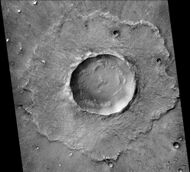Púnsk
Topic: Astronomy
 From HandWiki - Reading time: 5 min
From HandWiki - Reading time: 5 min
Púnsk is an impact crater on Mars, located in the Oxia Palus quadrangle at 20.8° N and 41.2° W. It measures 11.6 kilometers in diameter and was named after the village of Puńsk in Poland.[1]
Impact craters generally have a rim with ejecta around them, in contrast volcanic craters usually do not have a rim or ejecta deposits. As craters get larger (greater than 10 km in diameter) they usually have a central peak.[2] The peak is caused by a rebound of the crater floor following the impact.[3]
Punsk Crater belongs to the class of craters called "Rampart craters" of the single-ejecta variety. Single-layered ejecta craters are one type of rampart carter. They have one ejecta lobe that extends 1 to 1.5 crater radii from the rim of the crater. They have an average diameter of 10 km. Although present at all latitudes, they are most common near the equator. There average size increases the more distant from the equator. It has been suggested that these types of craters are produced by impact into icy ground. Specifically, it is an impact that does not go entirely through the icy layer. The increase in size away from the equator is explained by a possible greater thickness in the icy layer away from the equator.[4]
Punsk Crater, as seen by CTX camera (on Mars Reconnaissance Orbiter).
See also
- Impact crater
- Impact event
- List of craters on Mars
- Ore resources on Mars
- Planetary nomenclature
- Rampart crater
- Water on Mars
References
- ↑ "Púnsk". Gazetteer of Planetary Nomenclature. USGS Astrogeology Research Program.
- ↑ http://www.lpi.usra.edu/publications/slidesets/stones/
- ↑ Hugh H. Kieffer (1992). Mars. University of Arizona Press. ISBN 978-0-8165-1257-7. https://books.google.com/books?id=NoDvAAAAMAAJ. Retrieved 7 March 2011.
- ↑ Head, J., D. Weiss. 2017. Evidence for stabilization of the ice-cemented crysphere in earlier martian history: Implications for the current abundance of groundwater at depth on Mars. Icarus: 288, 120–147.
 KSF
KSF
